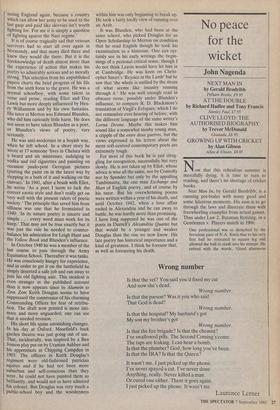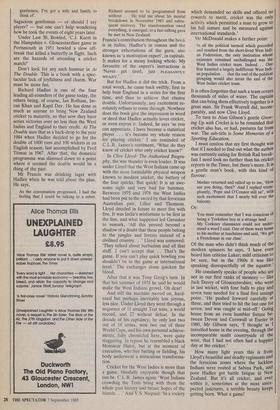No peace for the wicket
John Nagenda
NEXT MAN IN by Gerald Brodribb
Pelham Books, £9.95
AT THE DOUBLE by Richard Hadlee and Tony Francis Stanley Paul, £7.95 CLIVE LLOYD: THE AUTHORISED BIOGRAPHY by Trevor McDonald
Granada, £8.95
GROWING UP WITH CRICKET by Alan Gibson
Allen & Unwin, £8.95
Now that this ridiculous summer is mercifully dying, it is time to turn to reading, and there's no shortage of cricket books.
Next Man In, by Gerald Brodribb, is a cunning pot-boiler with many good and some hilarious moments. His ruse is to go through the laws and illustrate them with freewheeling examples from actual games. Thus under Law 2, Batsman Retiring, in a Gentlemen v. Players match in 1906:
One professional was so disturbed by the ferocious pace of N.A. Knox that to his very first ball he retreated to square leg and allowed the ball to crash into his stumps. He retired with the words, 'Good afternoon gentlemen, I've got a wife and family to think of'.
Sagacious gentleman — or should I say player? — but one can't help wondering how he took the events of eight years later.
Under Law 30, Bowled, `C.J. Knott in the Hampshire v. Gloucestershire game at Portsmouth in 1951 bowled a slow off- break that killed a butterfly in flight. Such are the hazards of attending a cricket match!'
Don't look for any such humour in At The Double. This is a book with a spec- tacular lack of joyfulness and charm. War must be more fun.
Richard Hadlee is one of the four leading all-rounders of the game today, the others being, of course, Ian Botham, Im- ran Khan and Kapil Dev. He has done as much as anyone to bring New Zealand cricket to maturity, so that now they have series victories over no less than the West Indies and England to their credit. At The Double uses that as a back-drop to the year 1984 when Hadlee decided to go for the double of 1000 runs and 100 wickets in an English season, last accomplished by Fred Titmus in 1967. After that, the domestic programme was slimmed down to a point where it seemed the double would be a thing of the past.
Mr Francis was drinking lager with Hadlee when he was told about the plan. He says, As the conversation progressed, I had the feeling that I could be talking to a robot. Richard seemed to be programmed from without . . . He told me about his mental breakdown in November 1983 and subse- quent recovery. The transformation owed everything, it emerged, to a fast-talking guru he met in New Zealand.
Francis's contribution throughout the book is in italics, Hadlee's in roman and the stronger exhortations of the guru, also known as 'a motivation expert', in capitals. It makes for a messy looking whole. My favourite of the expert's instructions is `Never get tired, just PLEASANTLY WEARY.'
But for Hadlee it did the trick. From a total wreck, he came back swiftly, first to help beat England in a series for the first time, and then to achieve that elusive double. Unfortunately, any excitement re- solutely refuses to come through. Nowhere does the book give the impression in word or deed that Hadlee actually loves cricket, or even enjoys it. Indeed, he says 'as you can appreciate, I have become a statistical player . . . it's become my whole reason for playing cricket.' I am reminded of C.L.R. James's sentiment, 'What do they know of cricket who only cricket know?'
In Clive Lloyd: The Authorised Biogra- phy, the war thunder is even louder. It was under Lloyd that the West Indians came up with the most formidable physical weapon known to modern cricket, the battery of the four quicks. But quick! It is an awe- some sight and very bad for batsmen. Between 1975 and 1976 the West Indies had been put to the sword by that ferocious Australian pair, Lillee and Thomson. Lloyd decided in future to meet fire with fire. It was India's misfortune to be first in the line, and what happened led Gavasker to remark, 'All this proved beyond a shadow of a doubt that these people belong to the jungles and forests instead of a civilised country. . .' Lloyd was unmoved: `They talked about barbarism and all that stuff. I can't accept that. . . That's the game. If you can't play quick bowling you shouldn't be in the game at international level.' The exchanges alone quicken the blood.
After that it was Tony Greig's turn. In that hot summer of 1976 he said he would make the West Indians grovel. Oh dear!
And still the machine moved on, hard- ened but perhaps inevitably less joyous, less nice. Under Lloyd they went through a sequence of 11 straight Test wins, a world record, and 27 without defeat. In the decade of his captaincy, he only lost two out of 18 series, won two out of three World Cups, and his own personal achieve- ments, fully chronicled here, were quite staggering. In repose he resembled a black Monsieur Hulot, but at the moment of execution, whether batting or fielding, his body underwent a miraculous transforma- tion.
Cricket for the West Indies is more than a game, blissfully enjoyable though that can be. C.L.R. James again: 'West Indians crowding the Tests bring with them the whole past history and future hopes of the islands. . .' And V.S. Naipaul: 'In a society which demanded no skills and offered no rewards to merit, cricket was the only activity which permitted a man to grow to his full stature and be measured against international standards.'
Mr McDonald makes a further point:
In all the political turmoil which preceded and resulted from the short-lived West Indi- an Federation, the only institution whose existence remained unchallenged was the West Indies cricket team. Indeed. . . One fear haunted a largely indifferent West Indi- an population. . that the end of the political grouping would also mean the end of the West Indies cricket team.
It is often forgotten that such a team covers thousands of miles of water. The captain that can bring them effectively together is a great man. Sir Frank Worrell did, incom- parably, and now Clive Lloyd.
To turn to Alan Gibson's gentle Grow: ing Up with Cricket is to be reminded that cricket also has, or had, pastures far from war. The sub-title is Some Memories of a Sporting Education. I must confess that my first thought was that if I needed to find out what the author was currently eating for British Rail break- fast I need look no further than his cricket reports in the Times, but there's more. It is a gentle man's book, with this kind of flavour: Mother returned and called up to me, `Hew are you doing, then?' And I replied trium- phantly, 'Pope and O'Connor still in!', with such excitement that I nearly fell over the balcony.
Or:
You must remember that I was conscious of being a Yorkshire boy in a strange land . • • My Cockney classmates could not under- stand a word I said. One of them went home to his mother at lunchtime and said, 'We get a Frenchman in our class'.
Of the man who didn't think much of the modern spinners he says, 'I have even heard him criticise Laker; mild criticism to be sure, but in the 1960s it was like speaking disrespectfully of the equator.
He constantly speaks of people who are not in our first ranks of memory — like Jack Davey of Gloucestershire, who went in last wicket, with four balls to play and seven runs needed for a final first innings point. 'He pushed forward carefully at three, and then tried to hit the last one for seven, and was caught at mid-off.' Going home from an even humbler fixture be- tween Devon and Cornwall at Exeter in 1980, Mr Gibson says, 'I thought as travelled home in the evening, through the incomparable sunlit countryside of the west, that I had not often had a happier day at the cricket.'
How many light years this is from Lloyd's beautiful and deadly regiments and the ferocious zones where the luckless Indians were routed at Sabina Park, and poor Hadlee got battle fatigue in New Zealand. But it's all cricket, and ever within it, sometimes at the most unex- pected junctures, a terrible beauty keeps getting born. What a game!











































 Previous page
Previous page